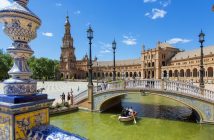The Venetians might not have invented the concept of cosmopolitanism, but Venice’s backbone of culture and trade has imbued it with a sophisticated, pan-cultural sensibility that has only increased through the centuries.
“The city has always been extremely cosmopolitan,” explains Gianmatteo Zampieri, manager of the Luna Hotel Baglioni, the oldest hotel in Venice. “There were no slaves, everyone was paid for their work. It was multicultural. People from the Dalmatian coast, Germany, France.”
As early as the 12th century, when the ideally positioned port city began to flourish, the Luna Hotel Baglioni’s site was home to the Knights Templar. Here, the skilled religious military order practised fighting and took in pilgrims en-route to the Holy Land.
But what could be holier than a view of the Canal Grande, the San Giorgio Maggiore Basilica and, in the distance, the Lido? Such was the fit-for-a-contessa vista from my corner junior suite at the Luna. Frankly, the five-star luxury property offers so many breathtaking vantage points that it’s tempting to ‘tour’ Venice without ever leaving the premises.
Guests staying in one of the sought-after altana (terraced) suites have the opportunity to lounge al fresco, locally-sourced libations in-hand (Spritzes and Bellinis) and toast the sentry-like statues adorning the former San Gimignano church. According to Zampieri, the place of worship was levelled by Napoleon at the turn of the 19th century to make way for a ceremonial stairway, which today leads visitors to the Correr Museum.
The Luna Baglioni itself feels much like a museum, with its classical interior stylings of silk-damask walls, antique furnishings and artwork, and Murano glassware. To visit an ancient city like Venice, it seems almost sacrilege to park oneself in some modern, gimmicky boutique hotel with geometrically shaped furniture. Going back in time is the only way to fully immerse oneself in this city of Marco Polo, Ottoman influences, and old carnival masks dramatic enough to make Tom Cruise circa Eyes Wide Shut look tame and sane (well almost sane).
Take just a few steps outside the Locanda della Luna (the hotel’s ancient name meaning ‘inn of the moon’), and you find yourself very much in the heart of historical Venice just behind Piazza San Marco. A short jaunt will take you to the world-famous Harry’s Bar, a shrine to the Bellini (which was born there). The upscale watering hole is well-reputed as the historic haunt of arts and culture luminaries like Alfred Hitchcock, Sinclair Lewis, Ernest Hemingway and Peggy Guggenheim. The latter’s former home, Palazzo Venier dei Leoni (aka the Guggenheim Museum) is situated just across the water in Dorsoduro. To access the nearby gallery and museum area, just walk out the hotel’s canal entrance and step right into a water taxi. The Luna has the special (albeit not unusual for palaces) distinction of having its own private jetty!
If you visit during Biennale, you couldn’t be more perfectly perched, five minutes by foot from Ca’ Giustinian, the headquarters for permanent Biennale activities. In an earlier incarnation, the building was a 19th century hotel frequented by arts figures including Verdi, Proust and Turner. This year, the Biennale drew an astounding 440,000 visitors from around the world. The event, founded in 1895, has clearly contributed greatly to Venice’s continued modern-era reputation as a sophisticated, cosmopolitan cultural hub.
The interior of the Luna Hotel Baglioni is replete with a similar potpourri of cultures and aesthetics. Apparently Baglioni Hotels’ owner, Commendatore Roberto Polito (a name that could stop traffic!) not only has a penchant for antiques but is a bit of a Francophile. So you will possibly spot a Louis XVI table, a Murano chandelier and Italian oil paintings, under the same roof.
Speaking of Italian oil paintings, 18th century works, by Tiepolo’s pupils, in the Salone Marco Polo ensure that breakfast is not only a nourishing meal but a soul-feeding endeavour as well. Every centimetre of the high ceiling is expertly painted. It’s one of those grand rooms in which, on entering, you practically hear clarion calls.
However, the real authentically Venetian dining experience is the hotel’s award-winning Canova restaurant, lorded over by Chef Cosimo Gianpaolo. A well-travelled Epicurean, his culinary influence has reached cities such as Moscow, Tokyo, London, Dubai, Stuttgart and Singapore. Accordingly, Canova’s cuisine promises a different take on Venetian food. In short: cosmopolitan.
Seafood dishes are not to be missed as they represent the very best of local texture and flavour juxtapositions: succulent along with subtly crispy, Venetian scallops paired with Porcini mushrooms. The lobster medallions with red onion from Tropea and Ligurian-flavoured vegetables are divine as are their home-made ravioli (most notably the special: cacao-filled ravioli).
Do not fear venturing into the meat and poultry arenas, especially when it comes to Venetian specialities like the liver with browned polenta, which is at once rich and supple. And do leave room for dessert, or several if you are gourmand enough to order the Count Baglioni platter, which includes a sort of history of desserts in small portions. There are ‘grown-up’ sweets like the zabaione sprinkled with amaretto cookie bits and Grand Marnier, and there are sprightly, playful desserts such as their rendition of a strawberry parfait, which is more perfetto than parfait.
Follow that with a couple of petite glasses of punch-packing grappa and it’s time to retire, full and nicely intoxicated, to your chambers, which are as opulently decorated as the desserts and liqueurs were rich.
And don’t bother setting an alarm. The church tower bells of St. Mark’s Basilica (‘the Campanile’), which resound at 7am, are likely to do the trick. Perhaps a bit of a conundrum for neophytes and night owls. However, a pleasure for historic culture vultures who want to ditch the soul-less call of the iPhone and wake up in the 15th century. Ancient Venice is calling!




